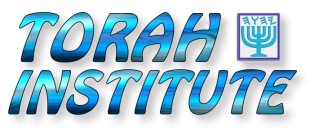

DOWNLOAD FREE PDF OF THIS ARTICLE - CLICK HERE
Also download many other tracts for free at
WHAT HAPPENED?
Have you ever
wondered what happened?
The pagan customs were adopted slowly after the first talmidim (Natsarim) fell asleep, as we read the letter of Polycrates to the elder in Rome.
The
Transformation Of Paganism
Truth Or Tradition - The Transformation Of Paganism
Acts 18 mentions the early expulsions of Torah-guarding Yahudim from the city of
Rome by emperor Claudius a few years prior to the destruction of Yerushalem. The
2nd century writings of Polycarp of Smyrna reveal in a letter to Victor, a
fellow elder in Rome, discouraging the observance of Easter, and encourage
Passover instead.
Polycrates emphatically stated that he was following the tradition passed down
to him:
“We observe the exact day; neither adding, nor taking away. For in Asia
also great lights have fallen asleep, which shall rise again on the day of the
Master's coming … All these observed the fourteenth day of the Passover
according to the besorah, deviating in no respect, but following the rule of
belief.
And I also, Polycrates, the least of you all, do according to the
tradition of my relatives, some of whom I have closely followed. For seven of my
relatives were bishops; and I am the eighth. And my relatives always observed
the day when the people put away the leaven [5].”
Emperor Theodosius (A.D. 78-398) officially forced Constantine's Catholicism the
State Religion of the Roman Empire, and made church membership compulsory. The
forced conversions filled the assemblies with unregenerate pagans, while
continuing to tax those who observed other beliefs.
Download a tract / article with more details on how the Fiscus Judaicus (a Roman
tax on Torah observers) slowly transformed the assemblies planted by the first
Natsarim into steeple-building pagans observing Sun-day and eating swine.
And what’s up with that fish?
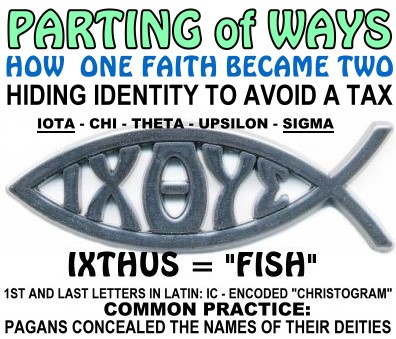
Our Mission Is About Our Message
Teaching all nations to obey everything He commanded us to obey sums up our
mission, and the message to them.
How this became muddled quickly at the beginning is explained by a TAX imposed
on the behavior of those obeying the Commandments.

Yahusha never taught
anyone to alter the Commandments, encode His Name, eat ham, meet in the morning
on the first work day of the week to remember His death, put bells and steeples
on meeting places, kneel down and worship bread discs, pray to His mother with a
rosary, or many other things. He told us to teach the Name and the Word to the
nations.
The 4th Commandment is not referring to “Sun-day,” so what happened?
People are eating pigs, bowing to images of crosses, fixing Easter
egg baskets, putting trees in their homes on December 25th, using steeples to
indicate a worship building, and generally doing all kinds of things without any
notion of their pagan origins.
How did we come to practice everything Yahuah told us not to practice (which
pagans were doing), and not practice a single thing He told us to practice?
While these things are blatantly obvious, why is it that so few seem to be awake
enough to notice?
What is His Name, and what is His Word?
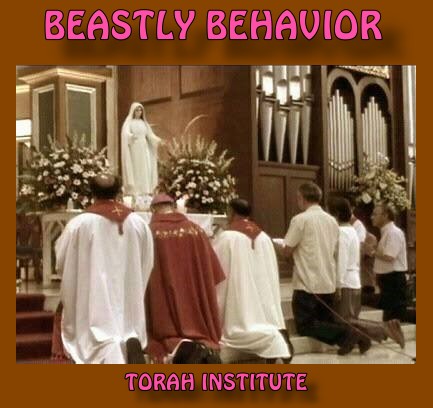

The Truth of what happened has been kept from everyone for too long, so here it
is in the simplest of terms.
Learn about the parting of ways; how one faith became two.
Pagans commonly concealed the names of their deities using codes which were
revealed to initiates by Mystagogues. As early Christianity developed, this
practice is what we see behind the fish symbol.
A Name was being concealed in codes such as IESV, IC-XC, or IHS.
PARTING OF WAYS:
HOW ONE BELIEF BECAME TWO
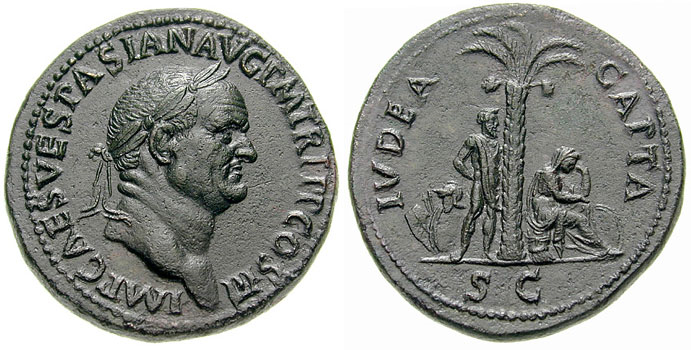
FREE PRINTABLE PDF ARTICLE CAN BE DOWNLOADED AT
www.torahzone.net/Parting-of-Ways-Article-Download.html
You could spend years of research trying to discover what you are about to read.
There is a reason for the massive difference between what is seen done and taught in Scripture, contrasted with what is practiced and taught today.
The myth that all the Hebrew-speaking men following Yahusha recorded their words in Greek, is only a symptom of a transformation on a grand scale.
The fiscus
Iudaicus (Latin for
"Jewish tax") or
fiscus Judaicus was
a tax-collecting directive instituted to collect the tax imposed by emperor
Vespasian on Yahudim (Ioudaios/Jews) over all the Roman Empire after the
destruction of Yerushalaim and its Temple in 70 CE. Revenues were directed to
support the temple of Iupiter Optimus Maximus in Rome. Vespasian and his son
Titus looted the gold from Yahuah's Mishkan (including the golden menorah), and
built the famous Roman Colosseum and two arches with the wealth they had
plundered from Yerushalem. The record of the Romans carrying away the golden
menorah is preserved on the carving inside the arch of Titus for all to see (photo
linked here). The misery continued for Torah observant believers
all over the Roman empire by way of taxation, and funded the pagan idolatry that
emerged from it, now going under the name Christianity.
Persons who
behaved like Yahudim, or met with them to study Torah-observance, whether or not
they were believers in Yahusha, were taxed.
This tax usurped the tithe that was originally sent to support the Temple.
It was redirected to lavishly support the pagan Roman religious institutions.
The only way
to be exempt:
abandon
Yahudaism.
TRANSFORMATION: YAHUDAISM TO
CHRISTIANITY
Before the
Temple was destroyed in 70 CE, there was
no separation whatsoever
between those who believed Yahusha is the Mashiak from those who did not.
Luke’s 2nd writing, Acts, is a record spanning about 30 years. It was written
between 60-62 CE, during the horrific reign of Nero.
The emperor Claudius had expelled all Yahudim from Rome in 49 CE, and we
know Aquila and Priscilla were of those expelled.
Paul met
with them at Corinth:
Act 18:2:
“And
he found a certain Yahudi
named Aquila,
born in Pontos, who had
recently
come from
Italy with his wife Priscilla,
because Claudius had commanded all the
Yahudim to
leave
Rome – and he came to them.”
About 3 years before Paul wrote the letter to the Romans, Nero lifted the edict
of
Claudius, so Yahudim were permitted to live at Rome again.
Even in the late 50’s when Paul wrote to the Romans, there was no separation or
parting between believers in Yahusha and those who met together without
believing.
HOW CHRISTIANITY
BEGAN TO SLOWLY DEVELOP AFTER 70 CE
Luke
recorded Acts only a few years prior to the destruction of Yerushalayim.
After the year 70, the pressure of taxation on anyone that observed Torah became
a factor in developing new behavioral patterns and terminology.
Because the Roman tax agency was watching closely, gentile converts felt they
did not owe the fiscus Iudaiscus, so they slowly withdrew and met separately.
To appear
distinct, they made as many changes as possible.
EVOLVING INTO A GENTILE SECT
Even before the destruction of Yerushalayim, Rome was watching those who would
not worship their emperors and pay homage to their deities. For this, the
Yahudim already had their attention.
To the
Romans, those who believed in Yahusha were a part of the same body of people
because they observed Torah in exactly the same way, and met with one another.
There are three perspectives; that of the pagan Roman magisterium, the Yahudim
who observed Torah and the traditions of the fathers, and the new third group
among them, the Natsarim. The Natsarim consisted of both former gentiles as well
as those of the natural branches of Yisharal. Because of the
fiscus Iudaicus,
those of the formerly gentile faction contemplated how they were different, and
should be treated as distinct by those imposing the tax. This distinction didn’t
matter at all, since they behaved exactly the same even if they did meet
separately from the main congregation they had once been a part of. We see this
even today, as congregations split apart for one reason or another. With the
annoyance of taxation, and being aware the tribute was used to support the pagan
Magisterium, a gradual shift began to take place as more converts entered the
fold.
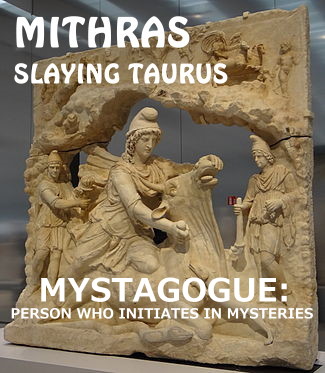
The average
pagan Roman citizen was living in a world that worshipped Mithras. Their
meetings took place in caverns or rooms built to resemble caverns, with an
indoor altar at one end of the space. The initiates progressed through grades or
levels, similar to the method seen today in Masonry. More Mithraic mysteries
were revealed as the adherent progressed to higher grades.
A mystagogue
explained the mysteries and theology to the initiate.
Very early,
unconverted pagans became joined to the body of true believers, just as we see
in groups today. As more converts from the pagan world entered into the
congregations of those motivated to avoid paying the fiscus Iudaiscus, the more
the behavior and surroundings took on their manner. Aspects such as steeples,
icons, genuflecting, holy water, indoor altars, haloes, or statues were never
part of the culture of Yisharal. To a Roman taxing official, the appearance of
the “new Christian” assembly would have been mostly like the Mithras
worshippers. The worshippers of Serapis at Alexandria were called “Christians”,
so adopting this label helped shield the now-corrupted followers of Yahusha from
appearing to be “Jewish”. Adopting all the accessories and gimmickry of the
pagans, the new group could attract far greater numbers from the general
population. The ignorant masses of pagans used the symbol of the crux widely as
a symbol for the sun, and so by the time of Constantine it became adopted to
link “Christ” with “Apollo”, Constantine’s most favored deity. As the dirty
snowball grew larger, the Latin language translation by Eusebius Sophronius
Hieronymus (Jerome) brought the term
crux
into the text, avoiding the word stauro, the Latin equivalent to the Greek
stauros. Now, the new faith even had a logo, the former symbol of sun worship:
the
solar cross.
Lawrence
Schiffman
(Yeshiva
University) writes: “The split between Judaism and Christianity did not come
about simply or quickly. . . Further, the question of legal status as seen
through Roman eyes also had some relationship to the issue.” Professor Schiffman
continues:
“The Romans
at first regarded the Christians as part of the Jewish people. When Christianity
spread and took on a clearly different identity, as acknowledged by both Jews
and Christians, the Roman government modified its view. The emperor Nerva (96–98
C.E.) freed the Christians (probably including the Jewish Christians) from
paying the fiscus judaicus, the Jewish capitation tax decreed as a punishment in
the aftermath of the revolt of 66–73 C.E. Clearly, the Romans now regarded the
Christians as a separate group. The way was paved for the legitimization of
Christianity as a licit religion. The decline of the old pagan cults, coupled
with the tremendous success of Christianity, would eventually lead to the
acceptance of the new faith as the official religion of the Roman Empire in 324
C.E.” Lawrence H. Schiffman, From
Text to Tradition, Ktav Publishing House,
Hoboken, NJ, 1991.
Q: WHY WOULD
THEY WANT TO HIDE THE NAME?
A: IT WAS
THE PRACTICE OF PAGANS TO DO SO.
HEBREW ROOTS
SEVERED COMPLETELY
Because the
taxing authorities were constantly snooping around, it was advantageous to
appear and sound completely distinct in every way. Trying to appear different,
the Hebrew roots of the faith were masked as much as possible, so changing terms
and altering names became acceptable.
The Greek
texts eliminated the Name, and put in its place a code, in case a snooping tax
agent were to examine them. In place of the Name Yahusha, a secretive
“Christogram” was used, which could only be understood through a mystagogue.
The "IY" (IU) in Greek manuscripts is an encoded "christogram", usually with a
bar over the letters (a titlos, meaning "title"), a substitution for the Name of
Yahusha.
IC XC,
IHS, and later Chi-Rho and IXTHUS, were used to conceal the Name.
LATIN CHRISTOGRAMS IN THE GREEK COPIES

Tampering
with Greek scripts, monks/mystagogues omitted the Mashiak’s Name in their
copies.
They adopted
the altered form for Yahusha, IHSOUS, from the Greek spelling in the Septuagint.
The 1st and
last letters of IHSOUS XRISTOS, IOTA-SIGMA & CHI-SIGMA (see
picture), were placed into the Greek copies with
Latin letters,
IC XC.
They mixed Latin letters with the Greek, leaving their Latin fingerprints
behind. The Greek letter SIGMA is represented as the letter “C” in Latin.
Because the word for “fish” in Greek begins and ends with IOTA & SIGMA, the word
IXTHUS
was turned into an acronym to further “mystify” initiates with their
mystagoguery.
The letters in the fish/ichthus are iota-chi-theta-upsilon-sigma, and were
mystically interpreted to stand for “Iesous Xristos Theou Huios Soter” meaning
“Iesu Xristos Theos Son Savior (Zeus was “Theos” to all Greeks).
SOUNDS LIKE
GREEK TO ME
The “congregations” described in the Natsarim Writings are often described by
the Greek term “synagogues”, and were not buildings. Even the term “synagogue”
helped to make them seem more “gentile”, since the word is Greek. The Hebrew
term SHUL was avoided. The group may have met in a room, or other place such as
Luke described at Acts 16:13 - by a
river. The word “church” originally was a pagan word describing a place of
worship. It is seen as kerk, kirk, kirke, circe, circus, cirice. Tyndale used it
only twice (Acts 14:13, 19:37) to describe the pagan houses of worship. He was
burned at the stake by Henry VIII for his translation, since church referred to
the authority (hierarchy) over the laity.
Tyndale used the word “congregation”, making all members of the body on
the same level.
DIVISIONS
- LACK OF UNITY
Read Acts
17. Paul goes to the Yahudi assemblies, on a day Luke refers to as “the
Shabath”. The noble “Bereans” checked Scripture to see if the things Paul said
were true. They were not “Christians”, and never became Sun-day observers that
ate pigs. Paul claimed he was a “Pharisee”, meaning he was brought up in the
discipline of the Prushim, one of the strictest sects of them all. After his
conversion, Paul was given a new perspective, and unity of the belief in
Yahusha’s deliverance was his aim; he did not teach against Torah, but
established it.
1Co 1:10:
“And
I appeal to you, brothers, by the Name of our Master Yahusha
Mashiak,
that you all agree, and that there be
no divisions among
you, but that
you be knit together in the same mind and in the same opinion.”
Paul saw Kefa behaving oddly around other Yahudim when eating with converts from the gentiles, and exposed such hypocrisy to his face (Gal. 2).
Paul knew distortions were coming after his work was done.
From Miletos, Paul called the elders of Ephesus to meet together.
This is what he told them:
“Therefore
take heed to yourselves and to all the flock, among which the Ruach ha’Qodesh
has made you overseers, to shepherd the assembly of Alahim which He has
purchased with His own blood. For I know this, that after my departure
savage wolves
shall come in among you, not sparing the flock.
Also from among yourselves men shall arise, speaking distorted teachings, to draw away the talmidim after themselves.”
Acts 20:28-30
BYNV
Paul’s
former Sanhedrin assignment (when was known as Shaul) was to arrest those in the
congregations who pronounced the Name aloud. This was forbidden, and carried the
death penalty, since uttering “Yahuah” was considered “blasphemy”. He watched
the robes of the men that stoned Stephen (Acts 7). After meeting Yahusha on the
road to Damascus, Paul was proclaiming the true Name, and teaching about
Yahusha. Having been arrested, Paul was confronted by the accusations of
Tertullus before Felix:
“For having
found this man a plague, who stirs up dissension among all the Yahudim
throughout the world, and a ringleader of the sect of the Natsarim . .
,”
Acts 24:5.
Later in this chapter, Paul claims to worship according to all that is written
in the Torah and the Prophets.
In other words, Paul’s way of life was nothing like modern Christianity.
He was of the sect of the “Natsarim”, and obeyed the Commandments.
The 7th day of the week was still Shabath to him.
Paul would not have been shocked about “Sun-day,” because he knew savage wolves
would later come teaching distortions. As savage wolves, they focus on
collecting the tithe yet forsake teaching Torah.
We are
witnesses of these distorted teachings, and as Yahusha’s Natsarim we overthrow
them with Truth, in love.
The doctrine
one lives by may come from one of two sources: Scripture (Yahuah’s inspired
instructions), or men’s traditions. Looking around this world, and listening to
what is normally taught, it is highly unlikely most people live by what
Scripture shows us as pleasing behavior before Yahuah.
Most of our
traditions come from pagan sources.
All of these
were inherited from pagans:
Sun-day
assemblies, statues, rosaries, holy water, Easter baskets (in place of Passover
and First-fruits), Christmas, wreath and tree-decorating, eating swine, sunrise
“services”, and praying in circles. Another huge stronghold is how everyone is
using a false name in place of the true identity of our Deliverer.
There is
only
one name
given among men for deliverance (Acts
4:12).
His Name is Hebrew.
The Name is
the Stone which the builders rejected (see Psalm, 118).
YashaYahu
52:6 tells us Yahuah’s people will know His Name, Yah Al (Joel) 2 quoted by Kefa
tells us those
calling on it
will be delivered, and Acts 4:12 tells us there is one
Name.
The Name and
the Word are above all else (Ps 138:2), and we Natsarim are the guardians of the
Name, and the Word, of Yahuah. What was whispered in the inner rooms is being
shouted from the rooftops. If the
Torah of Mosheh
is what we are told to “remember” before the Day of Yahuah comes, then that’s
what we should be telling everyone (Mal. 4:4-6).
Billions have never even heard the word “Torah” in their lives, and yet they support men to teach them the way of deliverance.
Come out of her, My people!
Repent, for
the Reign of Yahuah draws near!
NEW TRANSLATION
FOR MILLENNIALS:
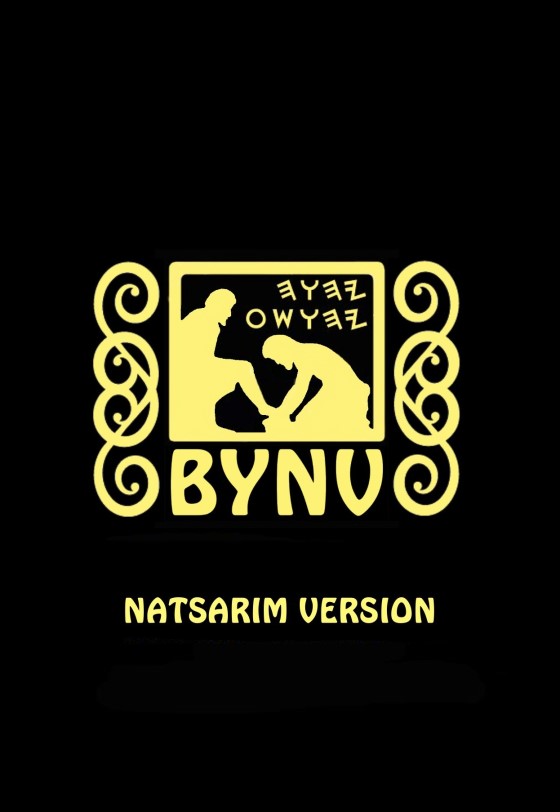 For the printed version (left) - click on picture here
For the printed version (left) - click on picture here
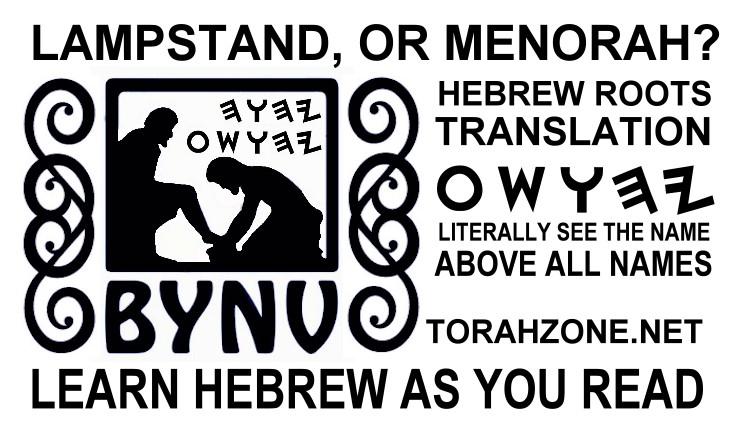
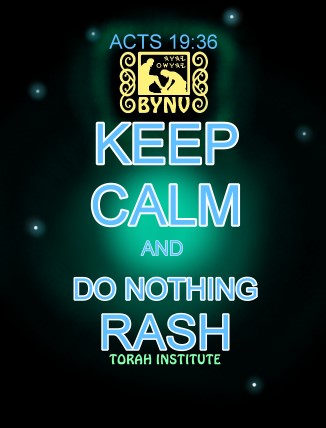
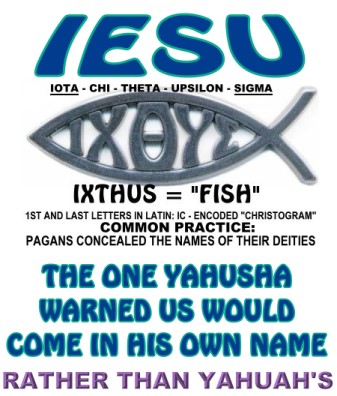

TORAH INSTITUTE
phone: 502-261-9833
Google: BYNV
